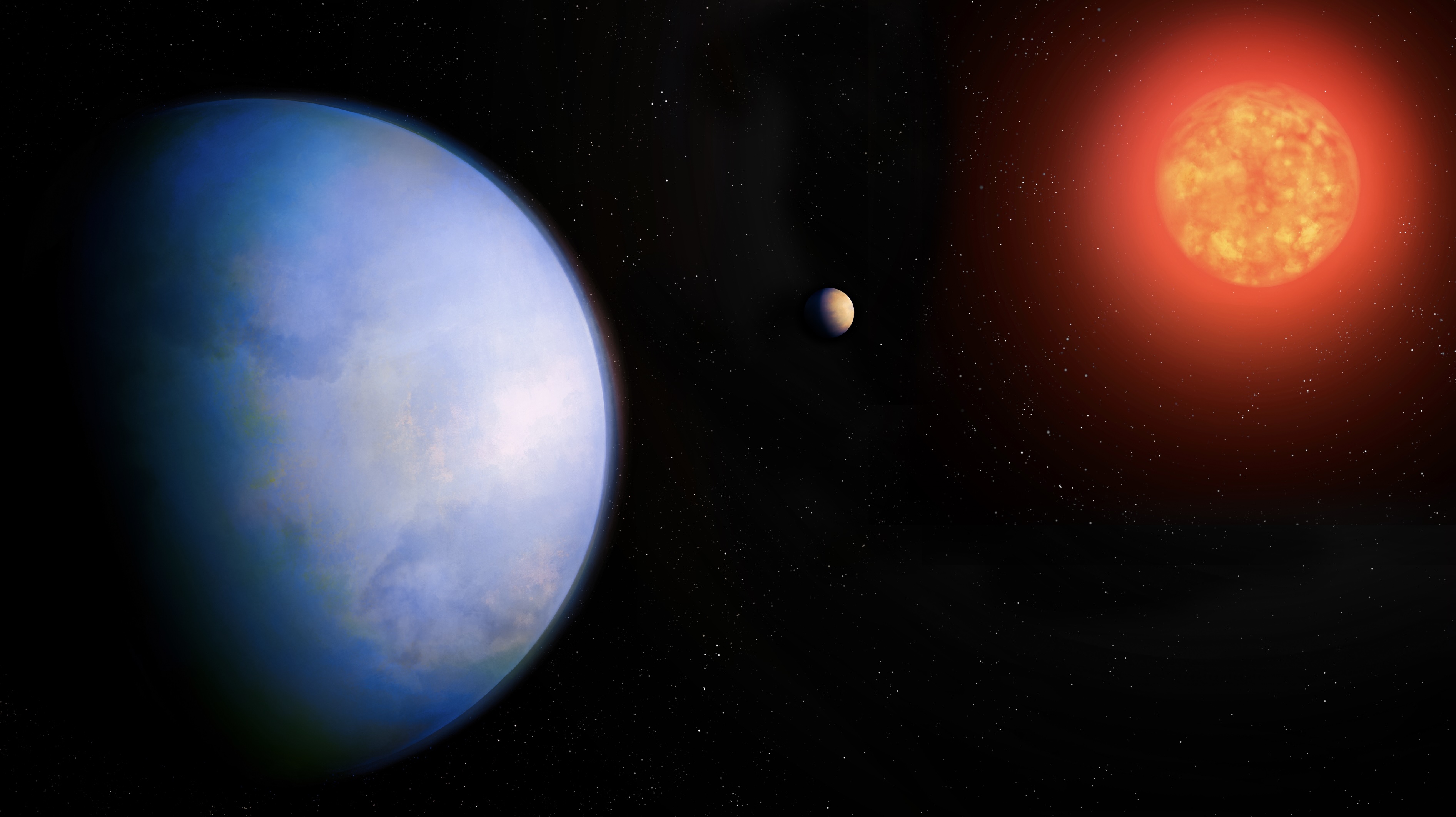UC Irvine astronomers discover nearby exoplanet in habitable zone

An artist’s conception of GJ 251 c, showing the planet (left), its host star (right), and a previously discovered planet that orbits closer to the star (middle).
- The work identifies an ideal target planet for the in-development Thirty Meter Telescope.
- The planet in question may be rocky like Earth and a few times more massive.
- NASA and National Science Foundation helped support the research.
Irvine, Calif., Oct. 23, 2025 — University of California, Irvine astronomers have identified an exoplanet located in a star’s habitable zone, where surface conditions might exist that can support the presence of liquid water – an essential ingredient for all known life. The exoplanet, which exists in a region of the Milky Way Galaxy that is relatively close to our solar system, may have a rocky composition like Earth and is several times more massive, making it a “super-Earth.”
The UC Irvine researchers and colleagues discuss their characterization of the exoplanet in a paper published today in The Astronomical Journal.
"We have found so many exoplanets at this point that discovering a new one is not such a big deal,” said co-author Paul Robertson, UC Irvine associate professor of physics & astronomy. “What makes this especially valuable is that its host star is close by, at just about 18 light-years away. Cosmically speaking, it’s practically next door.”
The exoplanet is called GJ 251 c, and it orbits an M-dwarf star, the oldest and most common type of star in our home Milky Way galaxy. M-dwarfs exhibit high levels of stellar activity, such as starspots (cool, dark regions on the star’s surface) and flares (sudden bursts of outward energy away from the star). Such stellar activity may mimic subtle RV signatures, resulting in a misleading exoplanet detection.
However, GJ 251 c’s proximity to Earth makes it an ideal target for future direct imaging studies with the University of California’s in-development Thirty Meter Telescope.
The large size of TMT’s mirrors may enable it to directly image faint exoplanets like GJ 251 c and confirm the presence of water.
“TMT will be the only telescope with sufficient resolution to image exoplanets like this one. It’s just not possible with smaller telescopes,” said Corey Beard, Ph.D., data scientist at Design West Technologies, a former graduate student from Robertson’s group and the study’s lead author.
The discovery of GJ 251 c was made possible by data from the Habitable-zone Planet Finder and NEID – exoplanet-hunting instruments Robertson helped build. HPF and NEID detect the subtle effects an orbiting exoplanet has on its host star.
As GJ 251 c’s gravity pulls on its host star, it creates small, rhythmic shifts in the star’s emitted light. HPF recorded these subtle shifts in light, which, known as radial velocity signatures, were used to determine the existence of the orbiting exoplanet.

HPF helps overcome some of M-dwarf’s stellar activity issues by observing the night sky in the infrared – a part of the spectrum where stellar activity signals are weaker.
The statistical significance of the team’s computational modeling work is strong enough to identify GJ 251 c as an exoplanet candidate, emphasizing the importance of future direct imaging observations with TMT.
“We are at the cutting edge of technology and analysis methods with this system,” said Beard. “While its discovery is quite statistically significant, we are still determining the status of the planet due to the uncertainty of our instruments and methods. We need the next generation of telescopes to directly image this candidate, but what we also need is community investment.”
Beard and Robertson hope that their work can motivate the exoplanet science community to further investigate GJ 251 c in preparation for the direct imaging capabilities of next-generation ground-based observatories like Thirty Meter Telescope.
Collaborators include Jack Lubin of UCLA; Eric Ford and Suvrath Mahadevan of Pennsylvania State University; Gudmundur Stefansson of the University of the Netherlands; and Eric Wolf of the University of Colorado, Boulder.
The work was supported by NSF grant AST-2108493 for the HPF exoplanet survey and NASA/NSF funding for NN-EXPLORE program (grant number: 1716038); NASA ICAR program 80NSSC23K1399.
About the University of California, Irvine: Founded in 1965, UC Irvine is a member of the prestigious Association of American Universities and is ranked among the nation’s top 10 public universities by U.S. News & World Report. The campus has produced five Nobel laureates and is known for its academic achievement, premier research, innovation and anteater mascot. Led by Chancellor Howard Gillman, UC Irvine has more than 36,000 students and offers 224 degree programs. It’s located in one of the world’s safest and most economically vibrant communities and is Orange County’s second-largest employer, contributing $7 billion annually to the local economy and $8 billion statewide. For more on UC Irvine, visit www.uci.edu.
Media access: Radio programs/stations may, for a fee, use an on-campus studio with a Comrex IP audio codec to interview UC Irvine faculty and experts, subject to availability and university approval. For more UC Irvine news, visit news.uci.edu. Additional resources for journalists may be found at https://news.uci.edu/media-resources.
